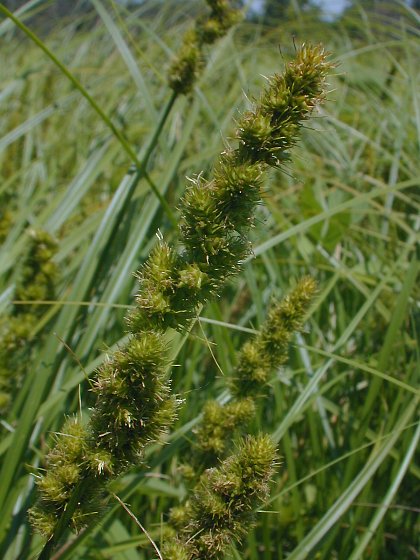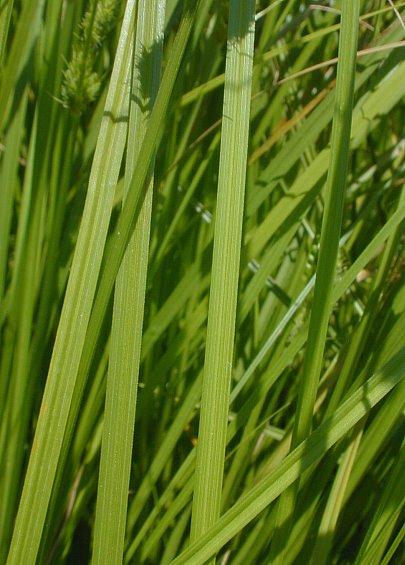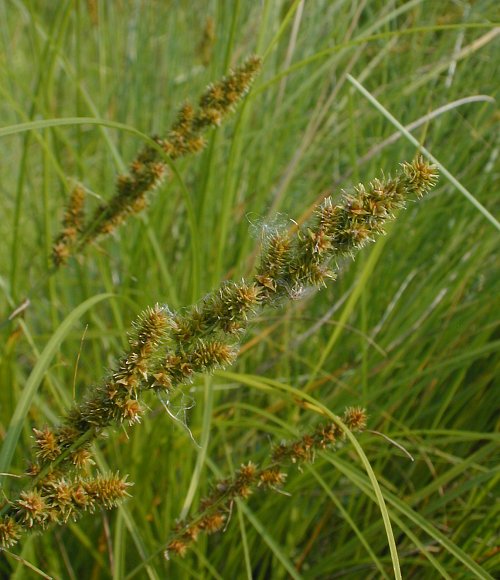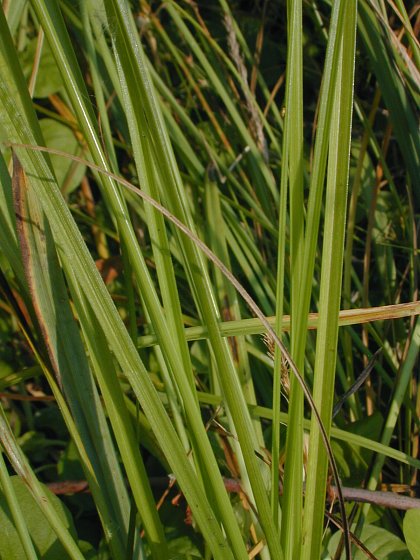Description: This perennial sedge is 1½–3½' tall, forming a dense tuft of leaves and flowering culms. The culms are light green, 3-angled, and glabrous (although slightly rough along the edges underneath the inflorescence). Several alternate leaves are located along the lower one-half of each culm; they are ascending to widely spreading. The narrow blades of the leaves are up to 5 mm. across and 3' long; they are light green, glabrous, longitudinally furrowed, and rough-textured along their margins. The leaf sheaths wrap tightly around their culms. The outer two sides of each sheath are light green, veined, and glabrous, while the inner side is membranous and usually concave at its apex. Each fertile culm terminates in a relatively straight inflorescence about 2-5" long and up to 15 mm. across. The inflorescence consists of several short lateral spikelets along its rachis (central stalk); adjacent spikelets usually overlap each other, although some of the lower spikelets may be sufficiently separated to produce short gaps between adjacent pairs. At the bases of some spikelets, there are bristly bracts up to 2" long, although they are usually much shorter than this. Each spikelet has a few male florets at its apex, while the female florets and their perigynia are located below. On each spikelet, the perigynia are ascending to widely spreading.

The perigynia are 2-3 mm. long and approximately 1.5 mm. across at maturity; they are ovoid-flattened in shape and glabrous, tapering into short beaks at their apices and rounded along their bottoms. The margins of these perigynia are wingless. The pistillate scales are about the same length as the perigynia, but they are more narrow and lanceolate. These scales have central green veins and membranous margins, terminating into short awn-like tips. The blooming period occurs from late spring to early summer, lasting about 1-2 weeks for a colony of plants. The florets are cross-pollinated by the wind. At maturity, the inflorescence of this sedge changes from green to golden yellow, yellowish brown, or brown. The perigynia disarticulate individually from their spikelets; they are distributed to some extent by wind or water. Each perigynium contains a single achene. The achenes are 1.0–1.5 mm. long and about one-half as much across, ovoid-flattened in shape, and glabrous; they are apiculate (tapering abruptly to a small narrow point) at their bases and sometimes at their apices. The root system is short-rhizomatous and fibrous. This sedge sometimes forms colonies of plants.

Cultivation:
The preference is full to partial sun, wet to moist
conditions,
and soil containing loam, silt, clay, and/or gravel. Sometimes this
robust sedge can spread aggressively, especially in disturbed areas
where there is reduced competition from other plants. Temporary
flooding is tolerated.
Range & Habitat:
The Brown Fox Sedge occurs in every county of Illinois (see Distribution
Map),
where it is common and native. This may be the most abundant sedge in
the state. Habitats include openings in floodplain woodlands, swamps,
soggy thickets, river-bottom prairies, prairie swales, sedge meadows,
low areas along ponds, gravelly seeps, streambanks, and ditches. This
sedge is often found in degraded wetlands and wetlands that are
seasonally flooded during the spring. Sometimes it is the dominant
sedge in sedge meadows.

Faunal Associations: Like other wetland sedges (Carex spp.), Brown Fox Sedge is a food plant of sedge grasshoppers (Stethophyma spp.), the Common Meadow Katydid (Orchelimum vulgare), caterpillars of several skippers (Poanes spp., Euphyes spp.), caterpillars of the Eyed Brown (Satyrodes eurydice), caterpillars of the Tufted Sedge Moth (Hypocoena inquinata) and other moths, semi-aquatic leaf beetles (Plateumaris spp.), the Sedge Billbug (Sphenophorus costicollis), seed bugs (Oedancala dorsalis, Cymus angustatus), plant bugs (Mimoceps insignis, Teratocoris discolor), the Yellow Sugarcane Aphid (Sipha flava) and other aphids, leafhoppers (Cosmotettix spp.), and other insects (see Insect Table). Some wetland birds feed on the seeds or seedheads of sedges in wetlands; these species include the Mallard and other ducks, Sora and Virginia Rail, Swamp Sparrow and other granivorous songbirds, Trumpeter Swan, and some sandpipers (see Bird Table). The Canada Goose also browses on the foliage of sedges. When the Brown Fox Sedge forms large colonies, it provides good cover for many species of wetland animals, including nesting habitat for the Sedge Wren.

Photographic
Location:
A sedge meadow at Judge Webber Park in Urbana, Illinois, and a prairie
swale at Meadowbrook Park in the same city.
Comments:
At maturity, Brown Fox Sedge (Carex
vulpinoidea) forms a large and attractive tuft of
narrow leaves. It is somewhat similar in appearance to some others
sedges, including Yellow Fox Sedge (Carex brachyglossa),
Bur-Reed Sedge (Carex sparganioides), and Cypress
Knee Sedge (Carex
decomposita). Yellow Fox Sedge produces a
less bristly inflorescence that becomes golden-yellow at maturity;
unlike Brown Fox Sedge, its leaves do not overtop the culms. Bur-Reed
Sedge has wider leaves and there are more gaps between its spikelets
along the inflorescence. Cypress Knee Sedge also has wider leaves and
the perigynia of its spikelets are obovoid-flattened in shape, rather
than ovoid-flattened. Other similar sedges have shorter inflorescences
that are less bristly in appearance, or their 3-angled culms are
conspicuously winged, or their leaf blades are wider than those of
Brown Fox Sedge.